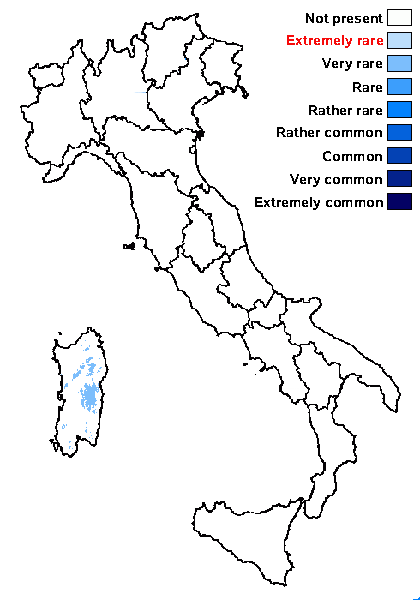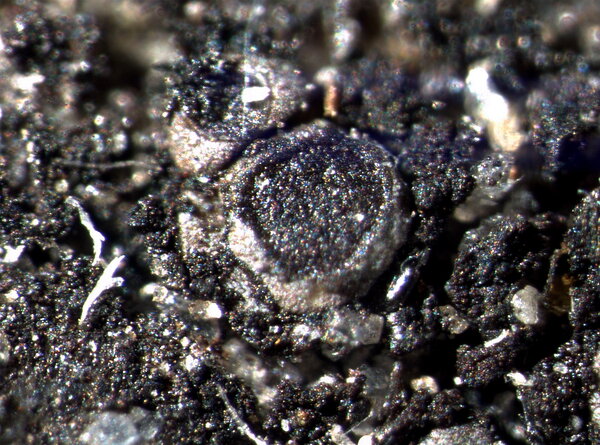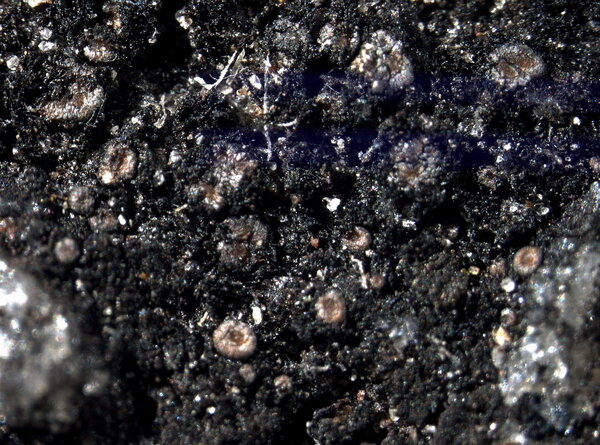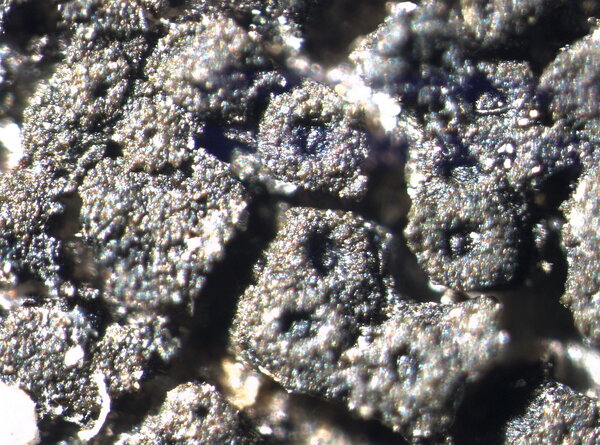Thelignya lignyota (Wahlenb.) P.M. Jørg. & Henssen
in Henssen & Jørgensen, Lichenologist, 22: 145, 1990. Basionym: Verrucaria lignyota Wahlenb. in Ach. - Meth. Lich.: 301, 1803.
Synonyms: Arctoheppia scholanderi (Lynge) Lynge; Porocyphus dispersus E. Dahl; Porocyphus ocellatus (Th. Fr.) Henssen; Psorotichia fuliginea (Ach.) Körb.; Psorotichia lignyota (Wahlenb.) Forssell; Psorotichia ocellata (Th. Fr.) Forssell; Pyrenopsis ocellata Th. Fr.; Thelignya fuliginea (Ach.) A. Massal.
Distribution: C - Sar.
Description: Thallus minutely squamulose to subcrustose, black to very dark olive-brown, dull or slightly glossy, 0.15-0.5 mm thick, consisting of irregularly shaped, (0.3-)0.4-1.5(-2) mm wide, confluent to rarely scattered, flat to uneven squamules with a rough surface, attached to the substrate by a minute, short, irregular stalk or basal gelatinous holdfast, often developing on cyanobacterial patinas. Thallus anatomy more or less paraplectenchymatous, the hyphae with short to slightly elongated cells, roundish to angular, forming an irregular network enclosing the photobiont cells. Apothecia 1-10 per areole, small, 0.25-0.4(-0.6) mm across, immersed to semi-immersed, with a black, pore-like to slightly expanded and usually soon umbonate disc, and a persistent, (10-)20-35(-50) µm thick, smooth thalline margin. Proper exciple thin, 10-15 µm wide at mid-level, 15-30 µm wide in upper part, colourless to bluish green; epithecium blue-green, K-, N-; hymenium colourless or faintly blue-green in upper part, 65-100 µm high, I-, soon with intrusions of agglutinated hyphae forming a central umbo; paraphyses sparse, irregularly branched and anastomosing, the apical cells slightly thickened; hypothecium colourless. Asci 8-spored, narrowly cylindrical-clavate, thin walled, without apical amyloid structures. Ascospores 1-celled, hyaline, broadly ellipsoid, 7.5-12 x 5.5-9 µm. Pycnidia immersed, simple, globose, c. 50 µm wide, the wall bluish green near the ostiole. Conidia cylindrical to subglobose, 2.5-3.5 x 1.5-2 µm. Photobiont cyanobacterial (Calothrix), filamentous, the tips of filaments tapered, basally often with heterocysts (but filaments often much contorted and split, sometimes better visible towards the base of the squamules), the individual cells 4-9 µm wide. Spot tests: all negative. Chemistry: without lichen substances.
Note: a more or less arctic-alpine species found on base- or lime-rich siliceous substrata, periodically submerged in cold creeks, or in seepage tracks; to be looked for also in the Alps.
Growth form: Crustose
Substrata: rocks
Photobiont: cyanobacteria, coccaceous (e.g. Gloeocapsa)
Reproductive strategy: mainly sexual
Periodically submerged (e.g. in creeks)
Commonnes-rarity: (info)
Alpine belt: absent
Subalpine belt: very rare
Oromediterranean belt: very rare
Montane belt: very rare
Submediterranean belt: absent
Padanian area: absent
Humid submediterranean belt: absent
Humid mediterranean belt: absent
Dry mediterranean belt: absent

Predictive model
Growth form: Crustose
Substrata: rocks
Photobiont: cyanobacteria, coccaceous (e.g. Gloeocapsa)
Reproductive strategy: mainly sexual
Periodically submerged (e.g. in creeks)
Commonnes-rarity: (info)
Alpine belt: absent
Subalpine belt: very rare
Oromediterranean belt: very rare
Montane belt: very rare
Submediterranean belt: absent
Padanian area: absent
Humid submediterranean belt: absent
Humid mediterranean belt: absent
Dry mediterranean belt: absent

Predictive model
 Index Fungorum
Index Fungorum
 GBIF
GBIF






